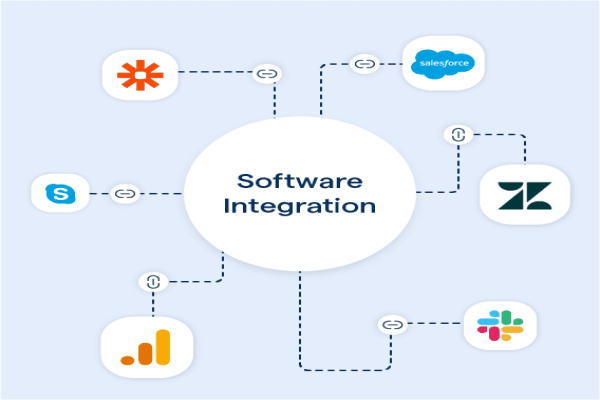It involves enabling communication, data exchange, and interoperability between disparate software entities, regardless of their underlying technologies, platforms, or programming languages.
In simpler terms, software integration allows different software systems to work together seamlessly, sharing data, resources, and functionalities to achieve common goals. This integration can occur at various levels, including:
Ensuring that data can flow freely between different systems, databases, and applications, regardless of their formats or structures. This often involves data mapping, transformation, and synchronization to maintain consistency and accuracy.
Enabling different software applications to interact and collaborate with each other, allowing users to access integrated functionalities and workflows across multiple systems. For example, integrating a customer relationship management (CRM) system with an email marketing platform to automate lead generation and follow-up processes.
Automating and orchestrating business processes that span multiple systems or departments, ensuring smooth workflow execution and coordination. This may involve workflow automation tools, business process management (BPM) systems, or integration middleware to manage process flows and dependencies.
Creating a unified user experience by integrating the user interfaces of different software applications or platforms. This allows users to access and interact with integrated functionalities seamlessly, without having to switch between multiple applications or interfaces.
Leveraging APIs and web services to enable communication and data exchange between different software systems in a standardized and secure manner. API integration allows developers to build integrations between applications without having to understand the underlying implementation details.

Determine what needs to be achieved through integration, such as data synchronization, workflow automation, or system interoperability.
Determine the key integration points where data exchange or communication needs to occur between different systems.
Evaluate the existing software systems, applications, and infrastructure to understand their functionalities, data structures, and integration capabilities.
Analyze the data models and schemas of the systems involved in the integration. Map the data fields, attributes, and structures between source and target systems to ensure compatibility and consistency. Define data transformation rules and logic to convert data formats, standards, or values as needed.
Design the overall integration architecture, including the integration patterns, protocols, and technologies to be used. Determine whether a point-to-point integration, hub-and-spoke integration, or enterprise service bus (ESB) architecture is most suitable for the project. Define the roles and responsibilities of each component or system involved in the integration.
Develop custom integration code, scripts, or connectors to facilitate data exchange and communication between systems. Configure middleware, integration platforms, or API management tools to orchestrate and manage the integration processes. Implement security measures, such as authentication, encryption, and access controls, to protect data during transit and at rest.
Conduct thorough testing of the integrated systems to ensure that data flows correctly, processes are executed as expected, and functionalities operate as intended. Perform integration testing, regression testing, and end-to-end testing to validate the reliability, performance, and scalability of the integration solution.
Seaco Software & Tech Solutions Private Limited is a leading provider of innovative IT solutions tailored to meet the diverse needs of businesses across industries.
A-813,Pranik Chambers, Saki Vihar Road,Sakinaka,Andheri East, Mumbai,Maharashtra,400072
+91-9152873655
seacosoftwareandtechsolution@gmail.com info@seacosoftware.comAll Rights Reserved | © Seaco Software